Dyeing a leather jacket is a great way to give it a new look and extend its lifespan. It’s a simple process that can be done at home with a few basic supplies. In this article, I will share with you my experience and knowledge on how to dye a leather jacket.
Before starting, it’s important to choose the right dye for your leather jacket. Leather dye works by penetrating deep into the leather fibers, so it’s crucial to pick a dye that is specifically made for leather. There are many different types of dyes available, including water-based, oil-based, and alcohol-based dyes. Each type has its own advantages and disadvantages, and I’ve covered them all in this article.
But if you directly want my recommendation, it is Angelus Acrylic Leather Paint. While it was originally made for shoes and boots, it works perfectly well on leather jackets too.
- WIDE APPLICATION: Our Angelus Acrylic leather paint is perfect for any smooth leather…
- QUICK DRYING AND FLEXIBLE: Our paint is quick to dry, flexible and will not crack or peel….
- WATER-BASED FORMULA: Angelus Acrylic leather paint has water-based formula so its not…
- NOT ONLY FOR SNEAKERS: This paint works perfectly on any leather surface. It can be…
How To Dye A Leather Jacket?

Dyeing a leather jacket is an easy process that can give your jacket a new look.
1. Mask Non-Leather Areas
Examine your leather jacket to identify parts that are not made of leather. This could include metal zippers, buttons, fabric linings, and other accessories. Ensure you have the masking tape or painter’s tape ready, along with a pair of small precision scissors if needed.
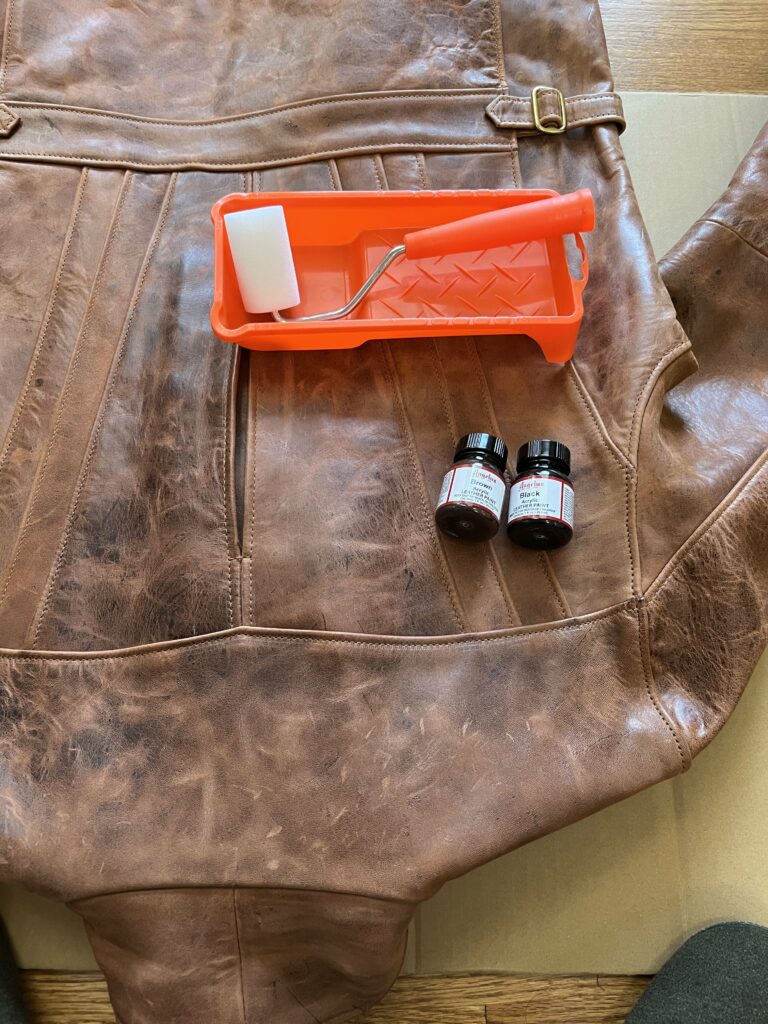
Start by carefully placing strips of masking tape over the non-leather areas that you want to protect. Make sure the tape adheres well but avoid pressing too hard, as leather can be sensitive to pressure marks. For areas with intricate shapes or small details, you might need to cut the tape into smaller pieces or shapes that match the contours of the non-leather parts. Precision scissors can be helpful for this task.
If necessary, overlap the edges of the tape to ensure complete coverage of the non-leather areas. This will create a barrier that prevents the dye or paint from coming into contact with these parts.
2. Applying the Dye
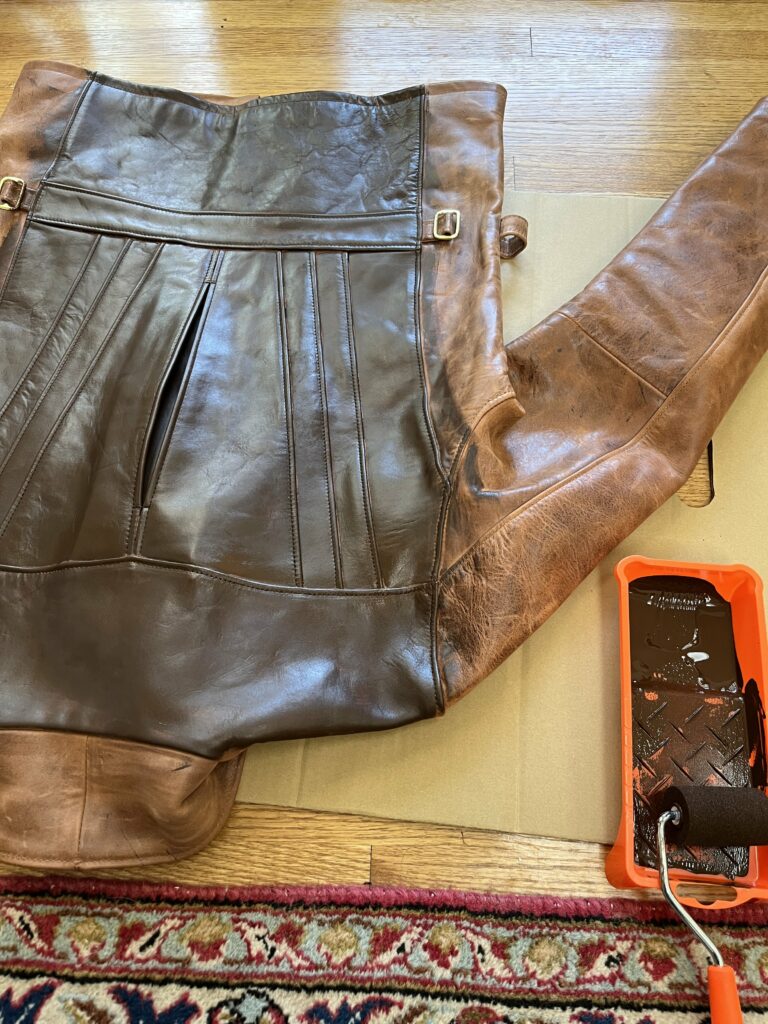
Before dyeing your leather jacket, you need to clean it thoroughly. Use a damp cloth to wipe off any dirt or dust. Once the jacket is clean, apply the dye using a sponge or brush. Make sure to apply the dye evenly, covering all areas of the jacket.
If you want to dye your leather jacket black, you can use a black leather dye. There are many brands of leather dye available in the market. Choose a dye that is specifically designed for leather and is of good quality.
If you’re using leather dye, follow the manufacturer’s instructions for application. Dyes are typically applied using a cloth or sponge applicator in thin, even layers. Allow each layer to dry before applying the next.
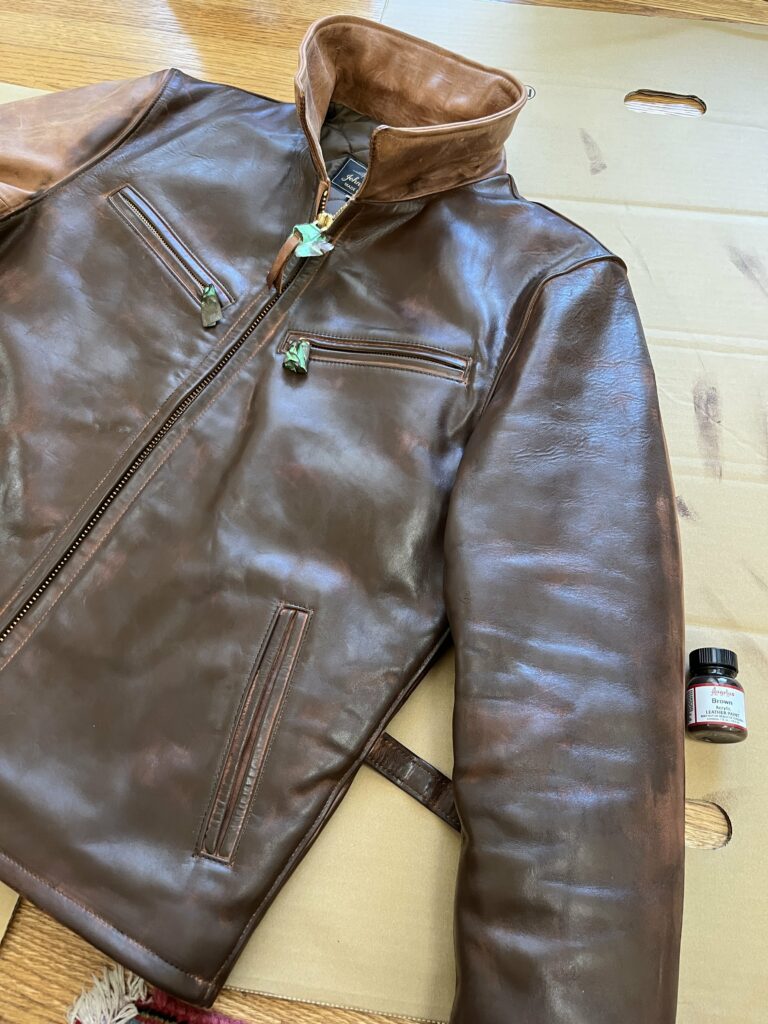
If you’re using leather paint, apply it according to the instructions provided. This might involve using multiple thin coats and allowing them to dry between coats.
Depending on the desired intensity of the new color, you might need to apply multiple coats of dye or paint. Be patient and allow each coat to dry before applying the next.
3. Drying Process
After applying the dye, let the jacket dry for at least 24 hours. Hang the jacket in a well-ventilated area, away from direct sunlight or heat. This will allow the dye to set properly and prevent any damage to the leather.
Once the jacket is dry, you can apply a leather conditioner to keep it soft and supple. A leather conditioner will also help to protect the jacket from cracking or drying out.
4. Conditioning the Jacket
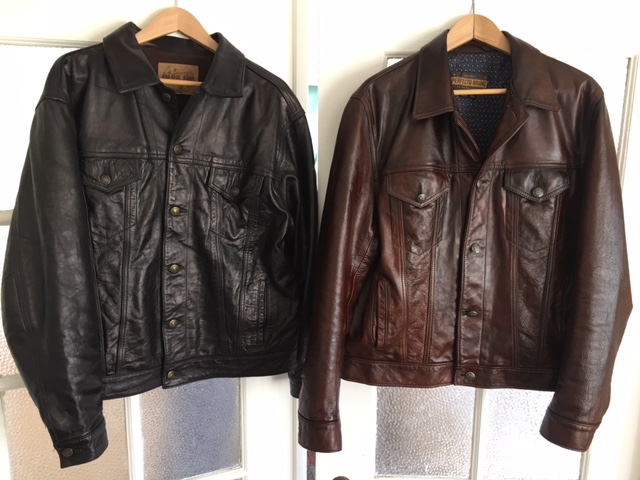
One of the most important steps in post-dyeing care is conditioning the jacket. Conditioning helps to keep the leather soft and supple, preventing it from becoming stiff or cracking over time. To condition your jacket, you can use a leather conditioner that is specifically formulated for use on dyed leather.
Apply the conditioner to a soft cloth and rub it into the leather in a circular motion. Be sure to apply the conditioner evenly and thoroughly, paying extra attention to any areas that may be prone to drying out, such as the elbows or seams.
5. Maintaining the Color
To maintain the color of your jacket, it is important to avoid exposing it to direct sunlight or heat for extended periods of time. UV rays can cause the color to fade over time, so it is best to store your jacket in a cool, dry place when not in use. You should also avoid using harsh chemicals or solvents on the leather, as these can strip the dye and cause the color to fade.
If you need to clean your jacket, use a mild soap and water solution and a soft cloth. Gently wipe the leather clean, taking care not to scrub or rub too hard. If you notice any areas where the color has faded or become uneven, you can use a leather color restorer to touch up the color.
Simply apply the restorer to the affected area and allow it to dry completely before wearing the jacket again.
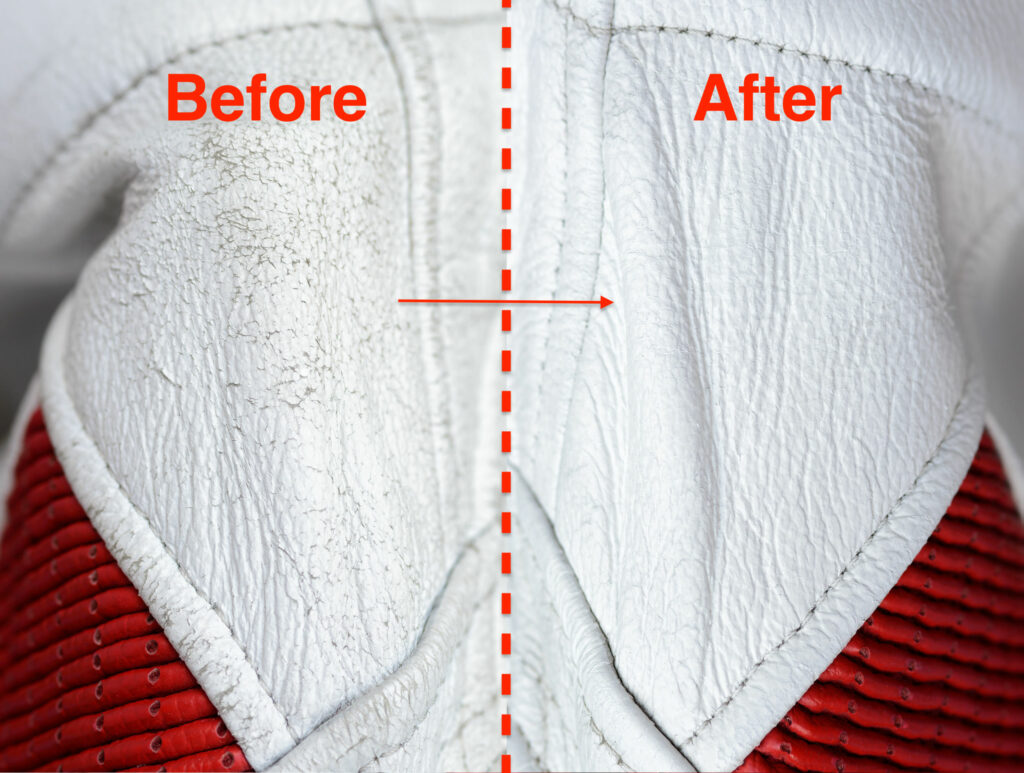
Can you dye a leather jacket at home?
Certainly, dyeing a leather jacket at home is possible, but several factors influence whether it’s a suitable choice for you:
1. Leather Type and Condition
Different types of leather react differently to dyes. Aniline and semi-aniline leathers tend to accept dyes more readily, while heavily coated or treated leathers might not take dye well. The condition of the leather also matters – if the leather is damaged, cracked, or heavily worn, dyeing might not effectively improve its appearance.
2. Desired Outcome
If you’re aiming for a subtle color change or refreshing the original color, dyeing at home might be a viable option. However, if you’re looking to achieve a significantly different color or a professional finish, it might be more challenging to achieve the desired result without specialized equipment and skills.
3. Equipment and Supplies
Proper dyeing requires specific leather dyes, applicators, and masking materials. Make sure you have access to the appropriate supplies to ensure an even and smooth dye application.
4. Personal Risk Tolerance
Ultimately, the decision to dye a leather jacket at home depends on your personal comfort level with the process and potential outcomes. If you’re willing to take on the challenges and are prepared for varying results, you can proceed with caution.
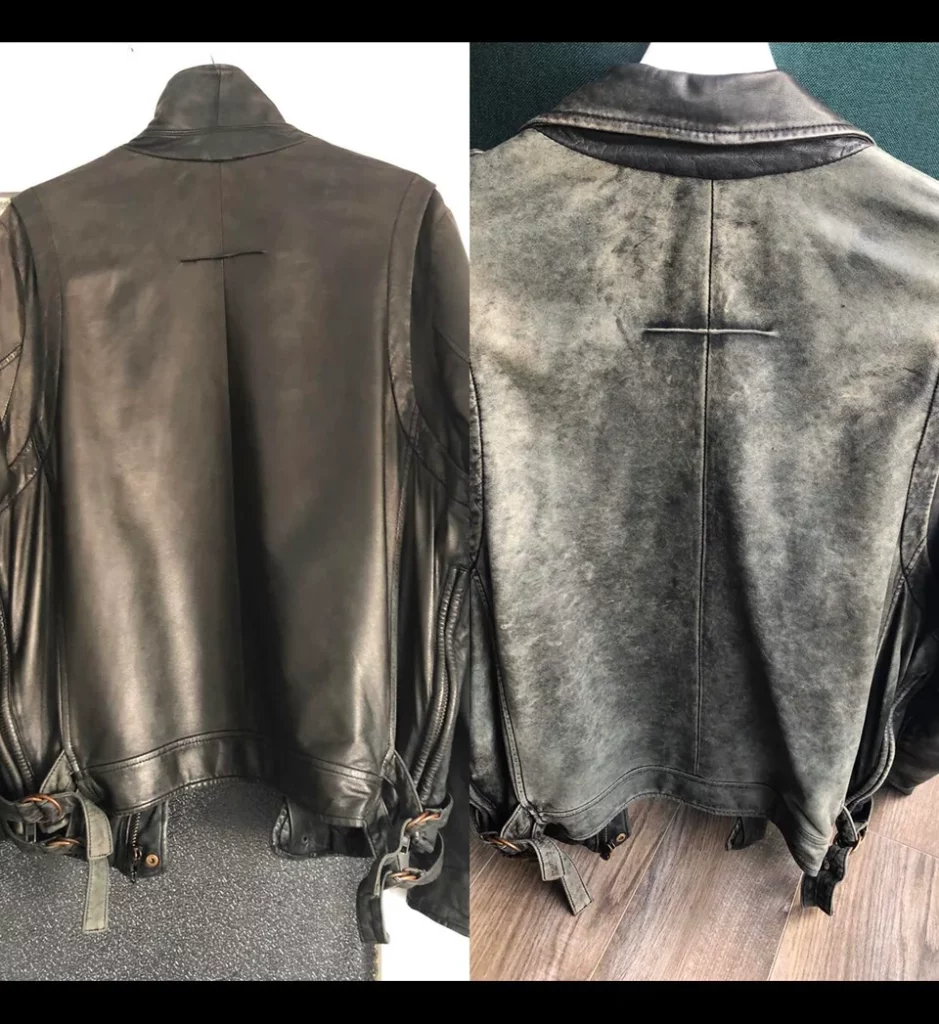
What kind of dye is best for leather?
The best type of dye for leather depends on the type of leather you’re working with and the desired outcome. Different dyes have distinct properties that make them suitable for various leather types and applications. Here are the main types of leather dyes along with their characteristics:
1. Water-Based Leather Dye
Water-based dyes are environmentally friendly and have low odor.
They are ideal for aniline and semi-aniline leathers, as they allow the natural characteristics of the leather to show through.
Water-based dyes are easy to work with, but they might require multiple coats to achieve the desired color intensity.
2. Alcohol-Based Leather Dye
Alcohol-based dyes penetrate deeply into the leather and are suitable for full-grain and top-grain leathers.
They offer vibrant and long-lasting colors, making them a popular choice for professional leatherworkers.
Alcohol-based dyes can dry quickly, so they require careful and even application to avoid streaking or uneven color.
3. Oil-Based Leather Dye
Oil-based dyes are often used for vegetable-tanned leather as they provide rich, deep colors.
They require more drying time and can darken the leather significantly.
Oil-based dyes provide excellent color saturation and can be blended to achieve custom colors.
4. Leather Paint
- WIDE APPLICATION: Our Angelus Acrylic leather paint is perfect for any smooth leather…
- QUICK DRYING AND FLEXIBLE: Our paint is quick to dry, flexible and will not crack or peel….
- WATER-BASED FORMULA: Angelus Acrylic leather paint has water-based formula so its not…
- NOT ONLY FOR SNEAKERS: This paint works perfectly on any leather surface. It can be…
Leather paints are opaque and can completely change the color of the leather.
They come in various forms, including acrylic and pigment-based paints.
Leather paints are often used for artistic or creative projects rather than traditional dyeing.
Before using any dye, it’s recommended to perform a patch test on a small, inconspicuous area of the leather to ensure that the dye adheres well and produces the desired result. Additionally, always follow the manufacturer’s instructions for application and safety precautions. If you’re uncertain about which dye to use or how to proceed, consulting with a professional leather artisan or expert can provide valuable guidance.
Final Remarks
In conclusion, dyeing a leather jacket is a creative pursuit that demands attention to detail and precision. Whether you’re aiming for a subtle transformation or a dramatic change, the process involves careful selection of dyes, meticulous leather preparation, and skillful application.
However, it’s crucial to acknowledge the potential complexities of dyeing leather at home. Factors like leather type, experience level, and desired results can influence success. For those seeking a polished outcome or uncertain about the process, consulting a professional leather artisan or dyeing service is a prudent choice.
In the end, dyeing a leather jacket is a blend of artistry and practicality. Balancing your vision with practical considerations will lead to a satisfying result, whether you choose to embark on this DIY journey or seek expert assistance.

My name is Alex Higson and I am the founder of Magic Of Clothes. I have worked in the fashion industry for many years, and clothes and style are a huge part of my life.

